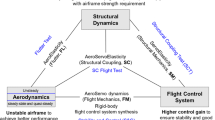Abstract
Methods are documented for active and passive damping studies with capabilities within NX I-deas and NX Nastran (http://www.ugs.com/products/nx/). The focus is on the methods that can be applied to a wide variety of products and design goals. Project examples are used to illustrate the methods and indicate the level of success obtained from real applications. Specific examples include passive damping for a liquid rocket engine, actuators for spacecraft interface that can suppress spacecraft response to launch vehicle vibration, active ceramic-fiber vibration suppression, constrained and free layer damping as well as the use of a secondary mode to increase effective damping or improve settling time of a manipulator arm.

















Similar content being viewed by others
References
Nastran NX, NX I-deas UGS website: http://www.ugs.com/products/nx/
Johnson CD, Kienholz.DA (1982) Finite element prediction of damping in structures and constrained viscoelastic layers. AIAA J 20(9):1284. AIAA 81–0486 R
Cass RB, Khan A, Mohammadi F (2003) Innovative ceramic-fiber technology energizes advanced cerametrics. American Ceramic Society Bulletin
Von Flotow AH, Hagood NW, Napolitano KL, Austin EM, David LP (1991) A case study in passive piezoceramic. In: Knowles GJ (ed) Proceedings of the ADPA/AIAA/ASME/SPIE conference on active materials and adaptive structures, Alexandria, Virginia. Viscous and viscoelastic damping. Active materials and adaptive structures, p 359
Baker M, Blelloch P, Burton T, Payne FM (1998) Design of damping treatment for the delta III RL10B-2 deployable nozzle. In: 39th AIAA structures, structural dynamics and materials conference, Long Beach, California, pp 20–23
Ellis RA et al (1997) Development of a carbon–carbon translating nozzle extension for the RL10B-2 liquid rocket engine. In: 33rd AIAA/ASME/SAE/ASEE joint propulsion conference & exhibit, Seattle, WA, AIAA 97–2672
Rogers L (1978) AFFDL/FBA wright paterson air force base report number AFFDL-TM-78–78-FBA. In: Damping materials and data and methods conference on aerospace polymeric viscoelastic damping technology for the 1980’s
Overst H, Frankenfeld K (1952) Acoustics, p 282
Cremer L, Heckle M (1987) Structure-borne sound, 2nd edn. Springer, Berlin Heidelberg New York, Translated and revised by E.E. Ungar
Author information
Authors and Affiliations
Corresponding author
Rights and permissions
About this article
Cite this article
Baker, M. Analysis methods to support design for damping. Engineering with Computers 23, 1–10 (2007). https://doi.org/10.1007/s00366-006-0022-1
Received:
Accepted:
Published:
Issue Date:
DOI: https://doi.org/10.1007/s00366-006-0022-1




